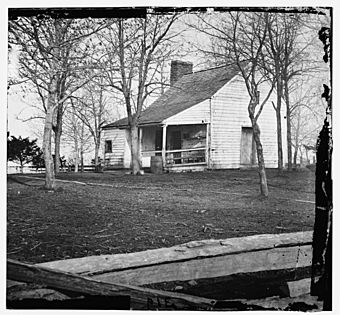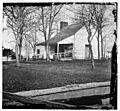Robinson House (Manassas, Virginia) facts for kids
Quick facts for kids |
|
|
Robinson House, Manassas National Battlefield
|
|
|
U.S. Historic district
Contributing property |
|

George N. Barnard took this photo of the Robinson House in 1862.
|
|
| Location | Bull Run, Virginia |
|---|---|
| Built | 1842 |
| Architect | James Robinson |
| Part of | Manassas National Battlefield Park (ID66000039) |
The Robinson House is a historic home located near Bull Run, Virginia. It sits at the bottom of Henry Hill. The house is named after the family of James "Gentleman Jim" Robinson. He was a free African American man who built the house. His family owned and lived in the house and much of the surrounding land from the 1840s until 1936. The National Park Service later bought the property. This was part of their plan to remember two big battles of the American Civil War. These were the First and Second battles of Bull Run. They are also known as the First and Second Manassas battles. Both battles were won by the Confederate side. Amazingly, the Robinson House survived these battles almost completely unharmed.
Contents
Life Before the Civil War
The Robinson family home was built in the 1840s. It was constructed by James "Gentleman Jim" Robinson. He was an African American man who bought the land from a local landowner, John Lee. James became one of the wealthiest African Americans in the area.
James was born free. His mother was a free African American woman, and his father was Landon Carter, Jr. James received an education when he was young. He took his tutor's last name, Robinson, to honor him. Even though he was born free, he had to work as a field laborer for a time. After this, he worked as a waiter in a tavern in Brentsville, Virginia. He had a good relationship with the tavern owner, Thomas Hampton. James used the money he earned to buy more land. In 1847, John Lee died. Lee owned land and enslaved people, including Jim's wife and children. When Lee died, Jim's family members were given to him in Lee's will. Jim brought them to live with him in his new home.
Around this time, Jim opened his own roadhouse. It was on the Warrenton Turnpike. This was the main road from Washington, D.C. to Richmond, Virginia. Richmond later became the capital of the Confederacy. This excellent location helped Jim become very wealthy. However, it also meant the Civil War would soon come right to his doorstep.
The Civil War and the Robinson House
Two major Civil War battles happened around the Robinson House. These battles brought the war directly to the family's home.
First Battle of Bull Run
During the First Battle of Bull Run, Union and Confederate troops fought fiercely. The map shows how the armies moved. Union forces, led by Erasmus Keyes, were completely defeated. Confederate forces, led by Thomas J. Jackson, held their ground very well. Because of his strong stand, Jackson became known as "Stonewall" Jackson. His soldiers held their line near the Robinson House. Union troops tried to break through their strong defense.
Before the fighting started, Gentleman Jim took his family to a neighbor's house. He hoped they would be safe there. After making sure his house was secure, Jim tried to rejoin his family. But he got caught in the middle of the battle. He had to hide under a bridge over Young's Branch of the Bull Run River. He stayed there until the fighting stopped. The first battle left thousands of bodies scattered across the fields. For days after the battle, the Robinsons helped bury many soldiers in unmarked graves. Even into the 1900s, family members said they were still finding soldiers' bones.
The first battle ended in just a few days. Many people thought the Civil War would be decided in one big battle. But this was not true. Confederate troops won the First Battle of Manassas. Federal troops went back to Washington, D.C. However, the Civil War continued for many more years.
Second Battle of Bull Run
The Second Battle of Bull Run lasted about a week. It also ended with a Confederate victory. Again, Federal troops retreated to Washington. The Confederates did not chase after them. Even more soldiers were hurt or died in this second battle. Union generals Pope and McClellan were outsmarted by Confederate generals Lee and Jackson. This happened even though the Union had more soldiers.
The battle again raged around the Robinson House. After the Henry House was destroyed in the First Battle of Bull Run, the Robinson House became very important. It was one of the most important buildings on the battlefield. Because of its location, it was used by the Union army. It served as a hospital for wounded soldiers and a place for planning. Gentleman Jim later told the Southern Claims Commission what happened. He said that after the battle, troops raided his farm. They took food and supplies. This caused more than $2,000 in damage to his property.
After the Civil War
Life changed for the Robinson family after the war. They sought help for the damages they suffered.
Seeking Compensation for Damages
On February 2, 1872, James Robinson presented his case to the Southern Claims Commission. This group was set up to handle claims from property owners. These owners had to prove they were loyal to the Union during the war. Jim's story and the statements from witnesses gave important details. They helped explain how Union and Confederate troops moved during the battles. Jim and his neighbors described how Union soldiers took food, livestock, fence posts, and other items from his house.
The Robinson House was also used as a field hospital. This happened during the Second Battle of Bull Run. A reporter described it this way:
The Robinson House was used as a Yankee hospital. I visited it this morning. I found 100 soldiers packed in the rooms. They were as thick as sardines. Many of their wounds were not bandaged. Blood had dried on their bodies and clothes. They were the most horrible group of people I had ever seen.
The Robinson Family After Jim's Death
Gentleman Jim died in 1875. His son, Alfred, then became the head of the household. Records show that Alfred lived with his mother and other family members. He led the Robinson family until he died in 1904. The house stayed in the family until 1936. That year, it was sold to the National Park Service (NPS). Today, the house site and the land around it are a key part of the battlefield park.
Manassas Battlefield Park Today
The Robinson House was one of the few homes on the battlefield that people lived in for a long time. Some other homes, like the Carter mansion at Pittsylvania, were already empty before the First Battle of Bull Run. The Henry House was completely destroyed during the First Battle of Bull Run. Its resident, Judith Carter Henry, died in the process. The Robinson House stayed standing. This was amazing, considering it was in the middle of heavy gunfire and artillery attacks.
Even though the house survived the Civil War, it was destroyed by people who set it on fire in 1993. The people who did it were never caught. But there was evidence that it was a hate crime. A few weeks before the fire, someone had spray-painted the house with hateful messages.
The National Park Service does not plan to rebuild the house. This is part of their current rules. However, they did dig up the property to learn more about it. This archaeological dig led to an important report. It tells the story of the house and the family who lived there. It covers their lives from before the Civil War into the early 1900s.
The site of the Robinson House is now part of the Manassas National Battlefield Park. It helps visitors understand the history of the area.
Images for kids




